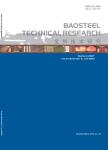Development and application of model for predicting molten metal temperature in continuous casting process
Development and application of model for predicting molten metal temperature in continuous casting process作者机构:Research InstituteBaoshan Iron &Steel Co.Ltd.Shanghai 201999China Shanghai Engineering Research Center of Strip Casting and RollingShanghai 201999China
出 版 物:《Baosteel Technical Research》 (宝钢技术研究(英文版))
年 卷 期:2019年第13卷第2期
页 面:10-16页
主 题:continuous casting strip casting molten metal temperature prediction model
摘 要:An unsteady mathematical thermal model was developed for predicting the time,molten-steel weight,induction heating power,and temperature changes of the steel from the end of ladle refining to the end of the continuous-casting process of a tundish. The calculations revealed that for a specific strip-casting process,the ladle tonnage should be controlled to about 90 t. If the ladle capacity reaches 130 t,the provision of a 1 500-kW tundish induction heating device is recommended. By comparing the measured and predicted molten-steel temperature values in the Ningbosteel-Baosteel strip casting industrialization demo project( NBS) of a tundish,it was determined that the prediction accuracy of the model could meet the forecasting accuracy requirements for the molten-steel temperature in the tundish during mass production. Simultaneously,the heat flux density on each surface of the tundish was found at about 50 min,which is entirely consistent with the values reported in the related literature,and the tundish had not reached a heat balance during the casting test period. This model can also be applied to calculate the suitable size of a tundish for a specific continuous-casting process,thereby providing a theoretical basis for the design of the continuous-casting tundish.



